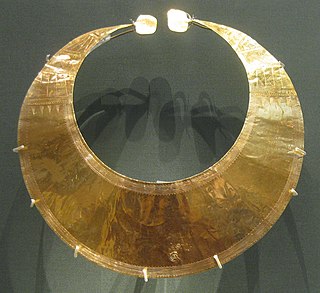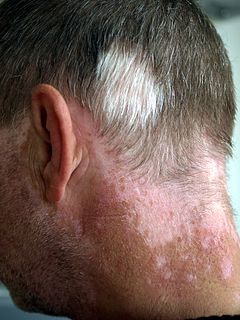
Hair loss, also known as alopecia or baldness, refers to a loss of hair from part of the head or body. Typically at least the head is involved. The severity of hair loss can vary from a small area to the entire body. Typically inflammation or scarring is not present. Hair loss in some people causes psychological distress.

Telogen effluvium is a scalp disorder characterized by the thinning or shedding of hair resulting from the early entry of hair in the telogen phase. It is in this phase that telogen hairs begin to shed at an increased rate, where normally the approximate rate of hair loss is 125 hairs per day.

Alopecia universalis (AU) or alopecia areata universalis is a medical condition involving loss of all hair, including eyebrows and eyelashes. It is an advanced form of alopecia areata.

The lunula, or lunulae (pl.), is the crescent-shaped whitish area of the bed of a fingernail or toenail. The lunula is the visible part of the root of the nail.

Dermatopathia pigmentosa reticularis (DPR), also known as dermatopathic pigmentosa reticularis, is a rare, autosomal dominant congenital disorder that is a form of ectodermal dysplasia. Dermatopathia pigmentosa reticularis is composed of the triad of generalized reticulate hyperpigmentation, noncicatricial alopecia, and onychodystrophy.

The Gold lunula is a distinctive type of late Neolithic, Chalcolithic or early Bronze Age necklace or collar shaped like a crescent moon. They are normally flat and thin, with roundish spatulate terminals that are often twisted to 45 to 90 degrees from the plane of the body. Gold lunulae fall into three distinct groups, termed Classical, Unaccomplished and Provincial by archaeologists. Most have been found in Ireland, but there are moderate numbers in other parts of Europe as well, from Great Britain to areas of the continent fairly near the Atlantic coasts. Although no lunula has been directly dated, from associations with other artefacts it is thought they were being made sometime in the period between 2200–2000 BC; a wooden box associated with one Irish find has recently given a radiocarbon dating range of 2460–2040 BC.

HLA-DR5 (DR5) is a broad-antigen serotype that is further split into HLA-DR11 and HLA-DR12 antigen serotypes.
Ophiasis is a form of alopecia areata characterized by the loss of hair in the shape of a wave at the circumference of the head.

Protein hairless is a protein that in humans is encoded by the HR gene.

Poliosis, also called poliosis circumscripta, is the decrease or absence of melanin in head hair, eyebrows, eyelashes or any other hairy area. It is popularly known as white forelock when it affects hair right above the forehead.
Central centrifugal cicatricial alopecia (CCCA), also referred to as hot comb alopecia and follicular degeneration syndrome, is a type of alopecia first noticed in African Americans in the 1950s and reported by LoPresti et al. in 1968 as a result of application of petrolatum followed by a stove-heated iron comb. The original theory was that the hot petrolatum would travel down to the hair root, burn the follicle, and after repetitive injury scarring would result. Later CCCA was realized to affect men and women without a history significant for use of such styling techniques. Consequently, the terms "follicular degeneration syndrome" per Sperling and Sau in 1992 and then CCCA per Olsent et al. in 2003 were evolved. Plausible contributing factors may include other African-American styling techniques such as relaxers, tight braids, heavy extensions, certain oils, gels or pomades.
Atrichia with papular lesions is a diffuse hair loss caused by an abnormality of the human homologue of the mouse hairless gene.
Blue nails, or more formally azure lunula, are characterized by a blue discoloration of the lunulae, seen in argyria and cases of hepatolenticular degeneration, also having been reported in hemoglobin M disease and hereditary acrolabial telangiectases.
Red lunulae is characterized by a dusky erythema confined to the lunulae, as has been reported in association with alopecia areata.

Trichoscopy is a method of hair and scalp evaluation and is used for diagnosing hair and scalp diseases. The method is based on dermoscopy. In trichoscopy hair and scalp structures may be visualized at many-fold magnification. Currently magnifications ranging from 10-fold to 70-fold are most popular in research and clinical practice.

Lidia Rudnicka is a Polish-American dermatologist with contributions to the field of scleroderma research, hair diseases and melanoma prevention.
Frontal Fibrosing Alopecia is the frontotemporal hairline recession and eyebrow loss in postmenopausal women that is associated with perifollicular erythema, especially along the hairline. It is considered to be a clinical variant of lichen planopilaris.
Mark G. Lebwohl, M.D., is an American dermatologist and author and the Sol and Clara Kest Professor and Chairman of the Department of Dermatology at the Mount Sinai Hospital in New York City. Lebwohl's books include the book on dermatologic therapy, Treatment of Skin Disease (ISBN 0323036031), as well as Atlas of the Skin and Systemic Disease (ISBN 044306539X). He has authored more than 400 publications, multiple book chapters and has been named as one of New York Magazine’s “Best Doctors” every year since the inception of the annual list.
In the field of dermatology, the Renbök phenomenon is a phenomenon where one skin condition inhibits another. It is also known as the reverse Koebner phenomenon. The term was first used by Happle et al. in 1991. The word "Renbök" is a neologism, made from a reversal of the letters of the name "Köbner".










